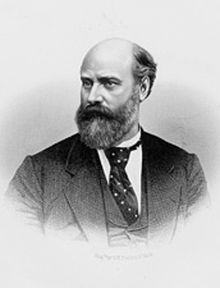Frederick A. Sawyer
Frederick Adolphus Sawyer | |
|---|---|
 | |
| United States Senator from South Carolina | |
| In office July 16, 1868 – March 4, 1873 | |
| Preceded by | James H. Hammond |
| Succeeded by | John J. Patterson |
| Personal details | |
| Born | December 12, 1822 Bolton, Massachusetts, U.S. |
| Died | July 31, 1891 (aged 68) Claiborne County, Tennessee, U.S. |
| Political party | Republican |
Frederick Adolphus Sawyer (December 12, 1822 – July 31, 1891) was a United States senator from South Carolina. Born in Bolton, Massachusetts, he attended the public schools, graduated from Harvard University in 1844, taught school in New England from 1844 to 1859, and took charge of the state's normal school at Charleston, South Carolina in 1859. He returned to the North during the Civil War, and returned to Charleston in February 1865 where he was active in advancing Reconstruction measures. On the night of April 14, 1865, Sawyer was at Ford's Theater in Washington, D.C., and witnessed the assassination of President Abraham Lincoln.[1] He was appointed collector of internal revenue in the second South Carolina district in 1865, and upon the readmission of the State of South Carolina to representation, Sawyer was elected as a Republican to the U.S. Senate, serving from July 16, 1868, to March 4, 1873. While in the Senate, he was chairman of the Committee on Education (Forty-first Congress) and a member of the Committee on Education and Labor (Forty-second Congress).
Sawyer was Assistant Secretary of the Treasury under William Adams Richardson from 1873 to 1874 and was employed in the United States Coast Survey from 1874 to 1880. From 1880 to 1887, he was special agent of the War Department. He conducted a preparatory school in Ithaca, New York, and gave private instruction to students in Cornell University. In 1889 he moved to Tennessee and became president of a land development company at Cumberland Gap, which laid out the new city of Shawanee (now part of Harrogate, Tennessee).[2]
Frederick Sawyer and his wife, Delia, had two daughters who both married into prominent political families.[2] Their elder daughter, Myra, married Charles Eugene Hamlin, grandson of Vice President Hannibal Hamlin. Myra Sawyer Hamlin wrote a series of books for girls, and her husband was editor of a weekly magazine for school teachers and a music critic for the New-York Tribune.[3]
Sawyer's younger daughter, Clara, married Isaiah Kidder Stetson, grand-nephew of Hannibal Hamlin and nephew of U.S. Congressman Charles Stetson. Isaiah K. Stetson owned a lumber and shipbuilding company in Bangor, Maine,[4] and served as Speaker of the Maine House of Representatives in 1899–1900.[5]
Sawyer died suddenly at Shawanee, Tennessee, in 1891; interment was in "Sawyer Heights", on the property of his land company, near East Cumberland Gap.[2]
References[edit]
- ^ "An Eyewitness Account of Abraham Lincoln's Assassination", edited by Ronald D. Rietveld, Civil War History (no date)
- ^ a b c of 1844, Harvard University Class (1896). The Class of 1844, Harvard College, Fifty Years' After Graduation. J. Wilson and Son.
{{cite book}}: CS1 maint: numeric names: authors list (link) - ^ "Myra Sawyer Hamlin". readseries.com. Retrieved 2016-04-09.
- ^ "Bio of Isaiah K. Stetson". www.onlinebiographies.info. Retrieved 2016-04-09.
- ^ "Speakers of the Maine House of Representatives, 1820-". legislature.maine.gov. Retrieved 2016-04-09.
- United States Congress. "Frederick A. Sawyer (id: S000086)". Biographical Directory of the United States Congress.


